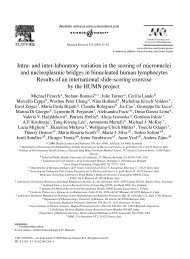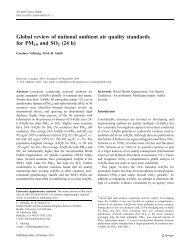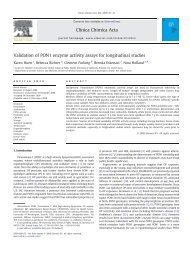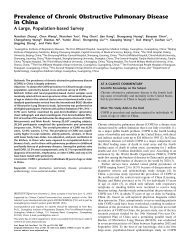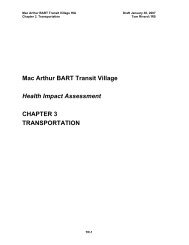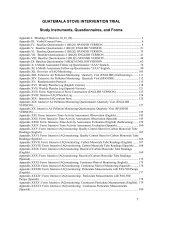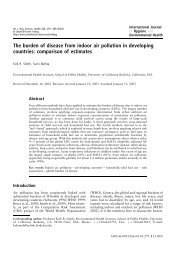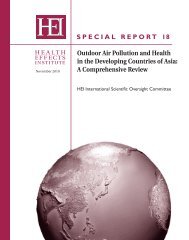Pesticide Toxicity and the Developing Brain - Environmental Health ...
Pesticide Toxicity and the Developing Brain - Environmental Health ...
Pesticide Toxicity and the Developing Brain - Environmental Health ...
You also want an ePaper? Increase the reach of your titles
YUMPU automatically turns print PDFs into web optimized ePapers that Google loves.
© 2008 The AuthorsJournal compilation © 2008 Nordic Pharmacological Society. Basic & Clinical Pharmacology & Toxicology, 102, 228–236Table 1.Summary of literature on organochlorine pesticide exposure <strong>and</strong> neurodevelopment in children. Average exposure levels are indicated where available.Author, year Population Exposure Outcome ResultsRogan et al. 1986 [8] n = 912 neonates ≤1 month oldBirth cohort from three healthcenters in North CarolinaBrazelton Neonatal BehavioralAssessment Scale (BNBAS)Gladen et al. 1988 [12]Rogan et al. 1991 [13]Gladen et al. 1991 [14]Stewart et al. 2000 [9]Darvill et al. 2000 [15]Ribas-Fitó et al.2003 [16]n = 858 children followedfrom birth to 1 yearBirth cohort from threehealth centers in North Carolinan = 676–18 monthsn = 670–24 monthsBirth cohort from three healthcenters in North Carolinan = 645–3 yearsn = 628–4 yearsn = 636–5 yearsn = 506 (report cards)Birth cohort from three healthcenters in North Carolinan = 141 exposed ≤2 days oldn = 152 unexposed(Oswego birth cohort)Exposure groups based onmaternal report of LakeOntario lifetime fishconsumption ≥40 lbs.Same cohort as in Stewart et al.• 230 at 6 months old• 219 at 12 months oldn = 92 infants 13 months oldBirth cohort living near anelectrochemical factory inSpainDDE – placenta, maternal<strong>and</strong> cord serum <strong>and</strong> milk/colostrums combined intoone measure/woman• Median ~2 p.p.m. in milk fatDDE – placenta, maternal <strong>and</strong>cord serum (prenatal exposure)<strong>and</strong> milk/colostrums(postnatal exposure)DDE – placenta, maternal<strong>and</strong> cord serum (prenatalexposure) <strong>and</strong> milk/colostrums(postnatal exposure)DDE – placenta, maternal<strong>and</strong> cord serum (prenatalexposure) <strong>and</strong> milk/colostrums(postnatal exposure)Cord serum levels DDE(median = 0.10 ng/g wet),HCB, MirexCord serum levels DDE, HCB,Mirex; breast milk on a subgroup(<strong>the</strong> primary exposure was PCB)Cord serum DDE (median =0.85 ng/mL) <strong>and</strong> HCBBayley Scales of InfantDevelopment (BSID-II):• Mental Development Index (MDI)• Psychomotor DevelopmentIndex (PDI)BSID-II:• MDI• PDI• McCarthy Scales of Children’sAbilities (MSCA): verbal,quantitative, motor, perceptualperformance, memory,general cognitive• School report cardsBNBAS at 12–24 hr <strong>and</strong> at25–48 hr after birthFagan Test of Infant IntelligenceBSID-II:• MDI• PDIGriffiths Scales ofInfant Development↑Dose-related number ofabnormal reflexes (hyporeflexia)Higher scores on regulation ofstates with borderline significancePrenatal exposure:↑MDI at 6 months = MDI at 12 months=PDI at 6 months = PDI at 12 monthsPostnatal exposure:= MDI/PDI at 6 <strong>and</strong> 12 monthsPrenatal exposure:=MDI & PDIPostnatal exposure:↑PDI at 24 months not at 18 months=MDIPrenatal exposure:• ↑/↓Diff in quant. score at 3, 4 <strong>and</strong>5 years with <strong>the</strong> lowest score at4 years – no dose–response <strong>and</strong>borderline significance• =for gradesPostnatal exposure:• ↑/↓Diff in motor score at 3, 4 <strong>and</strong>5 years with <strong>the</strong> lowest score at 4 years<strong>and</strong> no dose–response• =grades=performance on all clusters• 6 months, no association with DDE• 12 months, inverse correlation,r = –0.14, P = 0.03 (authors report that<strong>the</strong>re is no association)p,p′-DDE:↓MDI <strong>and</strong> PDI-dose-related2X dose of DDE ↓3.5 pointsMDI ↓4.0 points PDI↓Griffiths Scales: locomotor,personal-social, performance <strong>and</strong>eye-h<strong>and</strong> coordination(borderline significant)• Associations strongest if shorterperiod of breastfeeding230 BRENDA ESKENAZI ET AL. MiniReview
© 2008 The AuthorsJournal compilation © 2008 Nordic Pharmacological Society. Basic & Clinical Pharmacology & Toxicology, 102, 228–236Continued.Author, year Population Exposure Outcome ResultsEskenazi et al.2006 [11]Ribas-Fitó et al.2006 [17]Torres-Sánchez et al.2007 [18]Fenster et al.2007 [7]Engel et al. 2007 [10]n = 330 at 6 monthsn = 327 at 12 monthsn = 309 at 24 monthsCHAMACOS birth cohortliving in an agriculturalcommunity; mostly Latinofarmworker families inSalinas Valley Californian = 102 4-year-old childrenfrom Ribera d’Ebre cohortn = 405 4-year-old childrenfrom Menorca cohortSpanish childrenn = 225 at 1 monthn = 233 at 3 monthsn = 227 at 6 monthsn = 191 at 12 monthsMexican birth cohort(State of Morelos)n = 419 neonatesCHAMACOS birth cohortliving in an agriculturalcommunity; mostly Latinofarmworker familiesin Salinas Valley Californian = 151 neonatesMt. Sinai birth cohort inNew York City – r<strong>and</strong>omsubset of whole cohort(404 neonates) for this analysisTable 1.Maternal serum DDT <strong>and</strong> DDEat 26 weeks gestation (±2.9S.D.) for n = 334 or just beforedelivery for n = 26Mean exposures (ng/g lipid):p,p′-DDT = 22.0o,p′-DDT = 1.8p,p′-DDE = 1436.9Cord serum DDT <strong>and</strong> DDEMedian Ribera d’Ebre, Menorca:DDT: 0.05 ng/ml, 0.08 ng/mlDDE: 0.86 ng/ml, 1.03 ng/mlMaternal serum DDEMean exposures:Prepregnancy 6.8 ng/ml1st trimester 6.4 ng/ml2nd trimester 6.8 ng/ml3rd trimester 7.8 ng/mlMaternal serum DDT <strong>and</strong>DDE at 26 weeks gestation(±2.9 S.D.) for n = 334 orjust before delivery for n = 26Mean (ng/g lipid):p,p′-DDT = 23.2o,p′-DDT = 1.8p,p′-DDE = 1464.2Maternal serum DDEMedian = 0.6 µg/literBSID-II:• MDI• PDIMCSA:• General cognitive• Memory•VerbalReorganized McCarthy items:•Executive function• Memory span•Verbal memoryBSID-II:• MDI• PDIBNBASBNBAS•p,p′-DDT (1-log 10 increase):↓PDI at 6 (1.73 points) <strong>and</strong> 12 mo.(2.33 points) not at 24 months↓MDI at 12 (1.71 points) <strong>and</strong>24 (2.12) months not at 6 months•o,p′-DDT (1-log 10 increase):Borderline significant decrease inMDI at 12 (2.56 points) <strong>and</strong> 24(3.06 points) months not at 6 months•p,p′-DDE (1-log 10 increase):↓PDI at 6 months (2.14) notat 12 or 24 months=MDICombined cohorts• DDT:↓general cognitive (1.99), memory(3.79 borderline significant), verbal(2.63 borderline significant), executivefunction (2.61), memory span (2.82borderline significant) <strong>and</strong> verbalmemory (6.1 borderline significant)• DDE:↓memory (1.93) <strong>and</strong> ‡ in o<strong>the</strong>r domainsp,p′-DDE (1st trimester):• ↓PDI at 3 months (10.8),6 months (1.94)12 months (5.72)• =MDINo observed associations betweenmaternal DDT/DDE serum levels <strong>and</strong>neonatal performance on BNBASAuthors cite that single BNBASmay have limited sensitivityNo association↑↓ signifies a statistically significant effect in <strong>the</strong> indicated direction (P-value ≤0.05); = signifies no statistically significant effect. DDE, dichlorodiphenyldichloroethylene; DDT, dichlorodiphenyltrichloroethane.MiniReview PESTICIDES AND THE DEVELOPING BRAIN 231
232 BRENDA ESKENAZI ET AL. MiniReviewmeasured by any of <strong>the</strong> BNBAS clusters [7]. However, wedid observe a non-significant negative association betweenmaternal DDE serum levels <strong>and</strong> <strong>the</strong> number of abnormalinfant reflexes [adjusted β = –0.08 abnormal reflexes; 95%confidence interval (CI), –0.25, 0.08; P = 0.31] on <strong>the</strong>BNBAS [7].The results of <strong>the</strong> CHAMACOS study for DDE exposure<strong>and</strong> neonatal neurodevelopment are largely consistent witho<strong>the</strong>r studies with <strong>the</strong> exception of one earlier study ofinfants in North Carolina. One of <strong>the</strong> earliest studies toinvestigate effects in neonates of in utero exposure to DDEfound that higher levels of DDE in cord serum <strong>and</strong> breastmilk were associated with hyporeflexia on <strong>the</strong> BNBAS in abirth cohort of 912 infants in North Carolina [8]. However,<strong>the</strong>se findings were not replicated in a similar analysis of <strong>the</strong>Oswego, New York birth cohort [9]. Although <strong>the</strong> Oswegocohort study was smaller (n = 293), <strong>the</strong> BNBAS was administeredtwice during <strong>the</strong> first 2 days of life <strong>and</strong> no associationwas observed between exposure to DDE <strong>and</strong> performanceon <strong>the</strong> BNBAS. An analysis of a r<strong>and</strong>om subset of infantsfrom <strong>the</strong> Mt. Sinai Medical Center birth cohort (concurrentwith <strong>the</strong> CHAMACOS cohort) in New York City (n = 151)also found no association between maternal serum DDE<strong>and</strong> performance on <strong>the</strong> BNBAS [10]. Thus, <strong>the</strong> only studythat reported association of in utero DDE exposure <strong>and</strong>neonatal BNAS performance was <strong>the</strong> earlier North Carolinastudy conducted in 1986, which may be explained by higheraverage exposure levels. The median DDE exposure level in<strong>the</strong> North Carolina birth cohort was 12.06 p.p.b. that washigher than levels in our CHAMACOS cohort at 9.08 p.p.b.However, higher 95th percentile (151.92 p.p.b. versus34.60 p.p.b.) <strong>and</strong> maximum values (1219.73 p.p.b. versus180.00 p.p.b.) were detected in <strong>the</strong> CHAMACOS cohortcompared to <strong>the</strong> North Carolina cohort.The findings for DDE exposure <strong>and</strong> neurodevelopmentin older infants <strong>and</strong> children are less consistent than <strong>the</strong>findings for neonates. In <strong>the</strong> CHAMACOS study, we evaluatedinfant neurodevelopment at 6, 12 <strong>and</strong> 24 months using <strong>the</strong>Bayley Scales of Infant Development (BSID-II) <strong>and</strong> foundthat in utero exposure to DDE was only significantly associatedwith lower scores on <strong>the</strong> Psychomotor Development Index(PDI) at 6 months [11]. We also observed that DDE exposurewas associated with lower PDI scores at 12 months <strong>and</strong>lower Mental Development Index (MDI) scores at 12 <strong>and</strong>24 months, although <strong>the</strong> findings were not significant [11].In <strong>the</strong> North Carolina birth cohort, researches found apositive association between prenatal DDE exposure <strong>and</strong><strong>the</strong> MDI on <strong>the</strong> BSID-II at 6 months of age, but not onsubsequent assessments at 12, 18 or 24 months [12,13]. In<strong>the</strong> same cohort, researchers found that DDE exposure waspositively associated with <strong>the</strong> PDI of <strong>the</strong> BSID-II at 24months but not at 6, 12 or 18 months [12,13]. At 3, 4 <strong>and</strong> 5years, slight differences in development were detected inassociation with prenatal <strong>and</strong> postnatal DDE exposure in<strong>the</strong> North Carolina cohort using <strong>the</strong> McCarthy Scales ofChildren’s Abilities (MCSA) [14]. However, <strong>the</strong>re was noapparent dose–response relationship as <strong>the</strong> lowest scoreswere observed in <strong>the</strong> middle exposure category with higherscores in both <strong>the</strong> low <strong>and</strong> high exposure categories. Asecond study of <strong>the</strong> Oswego birth cohort evaluated infantsat 6 <strong>and</strong> 12 months using <strong>the</strong> Fagan Test of Infant Intelligence.Similar to <strong>the</strong> neonatal findings from <strong>the</strong> Oswego cohort,<strong>the</strong> authors reported no association between DDE levels incord serum <strong>and</strong> development at 6 months [15]. However, at<strong>the</strong> 12-month evaluation, <strong>the</strong>re was a significant negativecorrelation between DDE exposure <strong>and</strong> performance on <strong>the</strong>Fagan Test of Infant Intelligence [15]. These results weresimilar to those from a study of 92 children at 13 monthsfrom a birth cohort in Spain. The Spanish children exposedto higher levels of DDE had lower social, mental <strong>and</strong>psychomotor development as assessed by <strong>the</strong> GriffithsScales of Infant Development <strong>and</strong> <strong>the</strong> BSID-II [16]. Thesame authors evaluated 4-year-old children in <strong>the</strong> Riberad’Ebre <strong>and</strong> Menorca cohorts in Spain using <strong>the</strong> MCSA, <strong>and</strong>found that cord serum DDE levels were only associatedwith a decrease in <strong>the</strong> memory domain [17]. Finally,research with a Mexican birth cohort found that DDEexposure in utero was associated with a decrease in psychomotordevelopment using <strong>the</strong> BSID-II at 3, 6 <strong>and</strong> 12 months,but <strong>the</strong>re was no observed effect on mental development atany age [18]. Thus, results from <strong>the</strong> Spanish, Mexican <strong>and</strong>CHAMACOS cohorts suggest a negative effect of DDEon psychomotor development in infants 12 months <strong>and</strong>younger while <strong>the</strong> North Carolina study reported ei<strong>the</strong>r noassociation or a positive association in infants assessed at 6,12, 18 <strong>and</strong> 24 months. Mental development was found to bepositively associated with DDE exposure only in <strong>the</strong> earlyNorth Carolina study at 6 months, <strong>and</strong> all o<strong>the</strong>r studiesfound ei<strong>the</strong>r no association or a negative association.We also evaluated children’s neurodevelopment at 6, 12<strong>and</strong> 24 months in <strong>the</strong> CHAMACOS cohort in relation toDDT exposure. An increase in maternal serum DDT levelon <strong>the</strong> log scale was associated with a 1.71- <strong>and</strong> 2.12-pointdecrease on <strong>the</strong> BSID-II MDI at 12 <strong>and</strong> 24 months, respectively[11]. There was no significant association of serumDDT with <strong>the</strong> MDI at <strong>the</strong> 6-month assessment [11]. We didobserve a significant inverse association between maternalserum DDT <strong>and</strong> <strong>the</strong> psychomotor development scores on<strong>the</strong> BSID-II at 6 <strong>and</strong> 12 months but not at 24 months [11].Besides <strong>the</strong> CHAMACOS study, only one o<strong>the</strong>r study hasexamined <strong>the</strong> association between in utero DDT exposure<strong>and</strong> children’s development <strong>and</strong> results were similar. In <strong>the</strong>Spanish cohorts from Ribera d’Ebre <strong>and</strong> Menorca, highercord serum DDT levels were significantly associated withpoorer scores in <strong>the</strong> general cognitive <strong>and</strong> <strong>the</strong> executivefunction domains on <strong>the</strong> MCSA in 4-year-old children [17].Organophosphate pesticidesData are limited on <strong>the</strong> neurodevelopmental effects resultingfrom exposure to organophosphate pesticides <strong>and</strong> exposureassessment remains challenging (table 2). Organophosphatepesticide exposure is commonly assessed by measuringorganophosphate dialkylphosphate (DAP) metabolites in© 2008 The AuthorsJournal compilation © 2008 Nordic Pharmacological Society. Basic & Clinical Pharmacology & Toxicology, 102, 228–236
© 2008 The AuthorsJournal compilation © 2008 Nordic Pharmacological Society. Basic & Clinical Pharmacology & Toxicology, 102, 228–236Table 2.Summary of literature on organophosphate pesticide exposure <strong>and</strong> neurodevelopment in children. Average exposure levels are indicated where available.Author, year Population Exposure Outcome ResultsYoung et al.2005 [19]Rauh et al.2006 [21]Gr<strong>and</strong>jean et al.2006 [23]n = 381 ≤2 month oldsCHAMACOS birth cohortliving in an agriculturalcommunity; mostly Latinofarmworker familiesin Salinas Valley Californian = 254 children 0–3 yearsLongitudinal birth cohortstudy of inner-city mo<strong>the</strong>rsin New York Cityn = 72 Ecuadorianchildren 7 years old35 exposed (prenatal) children<strong>and</strong> 37 unexposed childrenMaternal urinary dialkylphosphatemetabolite levels during pregnancy(M = 14 <strong>and</strong> 26 weeks) <strong>and</strong> earlypostnatal (M = 7 days)Chlorpyrifos levels in umbilicalcord plasma classified ashigh if >6.17 pg/g plasmaPrenatal exposure assessed byquestionnaire with <strong>the</strong> mo<strong>the</strong>rCurrent exposure assessed byurinary pesticide metabolites(both dimethyl <strong>and</strong> diethylmetabolites were detectedin 31 children)Brazelton Neonatal BehavioralAssessment Scale (BNBAS)Bayley Scales of InfantDevelopment (BSID-II):• Mental Development Index (MDI)• Psychomotor DevelopmentIndex (PDI)• Child Behaviour Checklist (CBCL)Santa Ana Pegboard, WISC-R,Stanford-Binet copying subtest <strong>and</strong>finger tapping, Catsys force plate• ↑Dose-related number ofabnormal reflexes (hyporeflexia)with in utero measure especiallyin infants >3 days at testing• No association with earlypostnatal exposure measures• Linear regression analysis:↓3.327 points on MDI <strong>and</strong>6.46 on PDI at 36 months=at 12 <strong>and</strong> 24 months• Logistic regression analysis: Highexposure to chlorpyrifos associatedwith 2.37 (1.08–5.19) ↑odds ofmental delay at 36 months & 4.52(1.61–12.70) ↑odds of psychomotordelay at 36 months• CBCL: ↑in attention problems,attention deficit/hyperactivity disorder<strong>and</strong> pervasive developmental disorderPrenatal exposure:• ↓scores on <strong>the</strong> Stanford-Binet copyingtest (2.5 points versus 3.3 points)• =on <strong>the</strong> Santa Ana, meanreaction time, Digit Span forprenatal exposureCurrent exposure:• ↑in mean reaction time(500 msec. versus 426 msec.)• =on <strong>the</strong> Santa Ana, DigitSpan Forward or Stanford-Binetfor current exposure• Stunting modified resultsMiniReview PESTICIDES AND THE DEVELOPING BRAIN 233
© 2008 The AuthorsJournal compilation © 2008 Nordic Pharmacological Society. Basic & Clinical Pharmacology & Toxicology, 102, 228–236Continued.Author, year Population Exposure Outcome ResultsEngel et al.2007 [10]Eskenazi et al.2007 [20]n = 404 neonatesMt. Sinai birth cohortin New York City6 months n = 396 children12 months n = 372 children24months n = 372 children356 mo<strong>the</strong>rs – CBCL at24 monthsCHAMACOS birth cohortliving in an agriculturalcommunity; mostly Latinofarmworker families inSalinas Valley CaliforniaTable 2.Maternal dialkylphosphatemetabolites (DAPs) <strong>and</strong>malathion dicarboxylicacid (MDA) at mean 31.2weeks (S.D. 3.7 weeks)DAPs:Median diethyl metabolites =24.7 nm/literMedian dimethyl metabolites =47.8 nm/literMDA: median below limit of detectionMaternal <strong>and</strong> child urinarydialkylphosphate metabolites(DAPs) <strong>and</strong> maternal urinarymetabolite of malathion (MDA)<strong>and</strong> chlorpyrifos (TCPy)Mean maternal DAP: 114.9 nmol/lMean child DAP:45.5, 59.5 <strong>and</strong> 70.9 nmol/l at 6,12 <strong>and</strong> 24 monthsBrazelton Neonatal BehavioralAssessment Scales (BNBAS)Bayley Scales of Infant Development(BSID-II) at 6, 12 <strong>and</strong> 24 months:• MDI• PDIChild Behaviour Checklist(CBCL) at 24 months:• Attention• Attention deficit/hyperactivity disorder• Pervasive developmental disorder↑↓ signifies a statistically significant effect in <strong>the</strong> indicated direction (P-value ≤0.05); = signifies no statistically significant effect.DAPs:• total diethyl ↑abnormal reflexesrisk ratio 1.49 (95% CI, 1.12, 1.98)• total dimethyl ↑abnormal reflexes(non-significant but stronger forinfants assessed in first day of life)• total DAPs ↑abnormalreflexes (non-significantMDA: ↑abnormal reflexes risk ratio2.24 (95% CI, 1.55, 3.24) stronger forinfants examined in first 2 daysMaternal DAPs:↓Bayley MDI at 24 months=Bayley PDI at any age↑CBCL at 24 monthsChild DAPs↑Bayley MDI at 24 months=Bayley PDI at any age↑CBCL PDD at 24 monthsMDA <strong>and</strong> TCPy:=Bayley=CBCL234 BRENDA ESKENAZI ET AL. MiniReview
MiniReview PESTICIDES AND THE DEVELOPING BRAIN 235urine or by measuring <strong>the</strong> parent compound in blood. In<strong>the</strong> CHAMACOS cohort, we found that DAPs measured inprenatal maternal urine were associated with <strong>the</strong> number ofabnormal reflexes in neonates as measured by <strong>the</strong> BNBAS[19]. More than twice <strong>the</strong> number of neonates born tomo<strong>the</strong>rs in <strong>the</strong> highest exposure group had three abnormalreflexes or more compared to neonates born to mo<strong>the</strong>rs in<strong>the</strong> lower exposure groups. Similar to <strong>the</strong> results found forCHAMACOS neonates, Engel et al. reported increasednumbers of abnormal reflexes in infants born to mo<strong>the</strong>rswith higher levels of DAPs in urine during pregnancy in abirth cohort study from Mt. Sinai Medical Center in NewYork City [10]. Nei<strong>the</strong>r <strong>the</strong> CHAMACOS nor <strong>the</strong> Mt. Sinaistudy observed associations between organophosphatepesticide metabolites <strong>and</strong> o<strong>the</strong>r clusters of <strong>the</strong> BNBAS [6,15].In <strong>the</strong> CHAMACOS cohort, maternal DAPs were alsoassociated with decreased mental development scores on <strong>the</strong>BSID-II at 24 months (adjusted β = –3.54; 95% CI, –6.59,0.49; P ≤ 0.05) [20]. However, <strong>the</strong> observed associationbetween children’s concurrent DAP levels <strong>and</strong> mental developmentwas in <strong>the</strong> opposite direction. For every 10-foldincrease in a child’s DAP level, we observed a 2.37 point(95% CI, 0.50, 4.24) increase in <strong>the</strong> mental developmentscore on <strong>the</strong> BSID-II at 24 months [20]. Although we haveno clear explanation for this discrepancy, it is possible thatchildren with higher mental development scores are alsomore interactive with <strong>the</strong>ir environment <strong>and</strong> as a resultcome into contact with more pesticide residues. No associationswere observed between maternal or child’s DAP <strong>and</strong>BSID-II mental performance at 6 or 12 months of age orwith psychomotor performance at any of <strong>the</strong> three timepoints [20]. In a longitudinal birth cohort study fromColumbia University in New York City, researchers assessedinfants at 12, 24 <strong>and</strong> 36 months using <strong>the</strong> BSID-II [21].Chlorpyrifos (a common organophosphate pesticide) levelsin cord plasma were associated with decreases in mental <strong>and</strong>psychomotor development at 36 months but not at 12 or 24months. They did not assess <strong>the</strong> relationship of pesticideexposure during childhood <strong>and</strong> development.Results from <strong>the</strong> Child Behaviour Checklist (CBCL) weresimilar for both prenatal <strong>and</strong> postnatal pesticide exposure in<strong>the</strong> CHAMACOS cohort. The CBCL assesses a range ofbehaviour problems that produces scales consistent with <strong>the</strong>Diagnostic <strong>and</strong> Statistical Manual of Mental Disordersdiagnoses [22]. Maternal <strong>and</strong> child DAP levels were associatedwith an odds ratio of 2.25 (95% CI, 0.99–5.16) <strong>and</strong> 1.71(95% CI, 1.02–2.87), respectively, for maternally reportedpervasive developmental disorder (PDD) at 24 months [20].The PDD scale is made up of items such as ‘avoids eyecontact’, ‘rocks head, body’, <strong>and</strong> ‘unresponsive to affection’.No association was observed between maternal or child’sDAPS <strong>and</strong> CBCL-assessed attention problems at 24 months[20]. Researchers from Columbia also found associationswith maternal report of PDD <strong>and</strong> attention problems with<strong>and</strong> without hyperactivity at 36 months on <strong>the</strong> CBCL in<strong>the</strong>ir longitudinal birth cohort, similar to <strong>the</strong> results from<strong>the</strong> CHAMACOS study [21].One study from Ecuador examined <strong>the</strong> relationship ofexposure in older children <strong>and</strong> development. In a study of7-year-old children, Gr<strong>and</strong>jean et al. found that children’sDAP levels were associated with an increase in simple reactiontime while prenatal exposure, which was assessed by amaternal occupational questionnaire, was associated witha decrease on <strong>the</strong> Stanford-Binet copying test [23]. Nodifferences were reported for <strong>the</strong> Santa Ana Pegboard testor <strong>the</strong> Digit Span subtest of <strong>the</strong> Wechsler IntelligenceScale for Children in relation to ei<strong>the</strong>r prenatal or postnatalpesticide exposure. Currently, no o<strong>the</strong>r studies have beenpublished in older children [23].Conclusions <strong>and</strong> next stepsPrevious literature <strong>and</strong> recent work by <strong>the</strong> Centers forChildren’s <strong>Environmental</strong> <strong>Health</strong> Research provide evidenceof pesticide toxicity to <strong>the</strong> developing human brain. Animportant next step in this research endeavour is to pooldata from studies with similar methods <strong>and</strong> outcome <strong>and</strong>exposure measures. We are currently pooling data <strong>and</strong>comparing analyses from <strong>the</strong> Centers for Children’s <strong>Environmental</strong><strong>Health</strong> Research at University of California,Berkeley, Mt. Sinai School of Medicine <strong>and</strong> ColumbiaUniversity. Ano<strong>the</strong>r next step is to identify subpopulationsthat may be more susceptible to pesticide exposure <strong>and</strong>resulting neurodevelopmental health effects. For example, in<strong>the</strong> CHAMACOS cohort, we have found that an individual’ssusceptibility to organophosphate pesticides may vary byage <strong>and</strong> genotype. Children with a particular variant of <strong>the</strong>paraoxonase 1 gene had lower levels of <strong>the</strong> paraoxonaseenzyme that metabolizes organophosphate pesticides, whichmeans <strong>the</strong>y may be at higher risk of health effects fromorganophosphate exposure [24,25]. Future studies shouldexamine <strong>the</strong> neurodevelopment effects in human beingsassociated with pesticide mixtures <strong>and</strong> o<strong>the</strong>r classes ofpesticides (e.g. carbamates, pyrethroids), <strong>and</strong> with pesticidemixtures, because <strong>the</strong>re is increasing use of <strong>the</strong>se pesticidesin certain communities that are replacing <strong>the</strong> organophosphate<strong>and</strong> organochlorine pesticides.References1 Eskenazi B, Bradman A, Castorina R. Exposures of children toorganophosphate pesticides <strong>and</strong> <strong>the</strong>ir potential adverse heal<strong>the</strong>ffects. Environ <strong>Health</strong> Perspect 1999;107:409–19.2 Zwiener RJ, Ginsburg CM. Organophosphate <strong>and</strong> carbamatepoisoning in infants <strong>and</strong> children. Pediatrics 1988;81:121–6.3 California Department of <strong>Pesticide</strong> Regulation. <strong>Pesticide</strong> UseReport (PUR). Available from http://www.cdpr.ca.gov/docs/pur/purmain.htm, 2005.4 Axmon A, Rignell-Hydbom A. Association between biomarkersof exposure to persistent organochlorine compounds (POCs).Chemosphere 2006;64:692–4.5 Lu C, Bravo R, Caltabiano LM, Irish RM, Weerasekera G,Barr DB. The presence of dialkylphosphates in fresh fruitjuices: implication for organophosphorus pesticide exposure<strong>and</strong> risk assessments. J Toxicol Environ <strong>Health</strong> A 2005;68:209–27.© 2008 The AuthorsJournal compilation © 2008 Nordic Pharmacological Society. Basic & Clinical Pharmacology & Toxicology, 102, 228–236
236 BRENDA ESKENAZI ET AL. MiniReview6Bradman AS, Schwartz JM, Fenster L, Barr DB, Holl<strong>and</strong> NT,Eskenazi B. Factors predicting organochlorine pesticide levels inpregnant Latina women living in a United States agriculturalarea. J Expo Sci Environ Epidemiol 2006;16:388–99.7Fenster L, Eskenazi B, Anderson M, Bradman A, Hubbard A,Barr DB. In utero exposure to DDT <strong>and</strong> performance on <strong>the</strong>Brazelton neonatal behavioral assessment scale. Neurotoxicology2007;3:471–7.8Rogan WJ, Gladen BC, McKinney JD et al. Neonatal effectsof transplacental exposure to PCBs <strong>and</strong> DDE. J Pediatr1986;109:335–41.9 Stewart P, Reihman J, Lonky E, Darvill T, Pagano J. PrenatalPCB exposure <strong>and</strong> neonatal behavioral assessment scale(NBAS) performance. Neurotoxicol Teratol 2000;22:21–9.10 Engel SM, Berkowitz GS, Barr DB et al. Prenatal OrganophosphateMetabolite <strong>and</strong> Organochlorine Levels <strong>and</strong> Performanceon <strong>the</strong> Brazelton Neonatal Behavioral Assessment Scale ina Multiethnic Pregnancy Cohort. Am J Epidemiol2007;165:1397–404.11 Eskenazi B, Marks AR, Bradman A et al. In utero exposure todichlorodiphenyltrichloroethane (DDT) <strong>and</strong> dichlorodiphenyldichloroethylene(DDE) <strong>and</strong> neurodevelopment among youngMexican American children. Pediatrics 2006;118:233–41.12 Gladen BC, Rogan WJ, Hardy P, Thullen J, Tingelstad J, TullyM. Development after exposure to polychlorinated biphenyls<strong>and</strong> dichlorodiphenyl dichloroe<strong>the</strong>ne transplacentally <strong>and</strong>through human milk. J Pediatr 1988;113:991–5.13 Rogan W, Gladen B. PCBs, DDE, <strong>and</strong> child development at 18<strong>and</strong> 24 months. Ann Epidemiol 1991;1:407–13.14 Gladen BC, Rogan WJ. Effects of perinatal polychlorinatedbiphenyls <strong>and</strong> dichlorodiphenyl dichloroe<strong>the</strong>ne on later development.J Pediatr 1991;119:58–63.15 Darvill T, Lonky E, Reihman J, Stewart P, Pagano J. Prenatalexposure to PCBs <strong>and</strong> infant performance on <strong>the</strong> fagan test ofinfant intelligence. Neurotoxicology 2000;21:1029–38.16 Ribas-Fito N, Cardo E, Sala M et al. Breastfeeding, exposureto organochlorine compounds, <strong>and</strong> neurodevelopment in infants.Pediatrics 2003;111:e580–5.17 Ribas-Fito N, Torrent M, Carrizo D et al. In utero exposure tobackground concentrations of DDT <strong>and</strong> cognitive functioningamong preschoolers. Am J Epidemiol 2006;164:955–62.18 Torres-Sanchez L, Ro<strong>the</strong>nerg SJ, Schnaas L et al. In uterop,p′-DDE exposure <strong>and</strong> infant neurodevelopment: a perinatalcohort in Mexico. Environ <strong>Health</strong> Perspect 2007;115:435–9.19 Young JG, Eskenazi B, Gladstone EA et al. Association betweenin utero organophosphate pesticide exposure <strong>and</strong> abnormal reflexesin neonates. Neurotoxicology 2005;26:199–209.20 Eskenazi B, Marks AR, Bradman A et al. Organophosphatepesticide exposure <strong>and</strong> neurodevelopment in young Mexican-American children. Environ <strong>Health</strong> Perspect 2007;115:792–8.21 Rauh VA, Garfinkel R, Perera FP et al. Impact of prenatalchlorpyrifos exposure on neurodevelopment in <strong>the</strong> first 3 yearsof life among inner-city children. Pediatrics 2006;118:e1845–59.22 American Psychiatric Association. Diagnostic <strong>and</strong> StatisticalManual of Mental Disorders. American Psychiatric Association,Washington, DC, 2000.23 Gr<strong>and</strong>jean P, Harari R, Barr DB, Debes F. <strong>Pesticide</strong> exposure<strong>and</strong> stunting as independent predictors of neurobehavioral deficitsin Ecuadorian school children. Pediatrics 2006;117:e546–56.24 Holl<strong>and</strong> N, Furlong C, Bastaki M et al. Paraoxonase polymorphisms,haplotypes, <strong>and</strong> enzyme activity in Latino mo<strong>the</strong>rs <strong>and</strong>newborns. Environ <strong>Health</strong> Perspect 2006;114:985–91.25 Furlong CE, Holl<strong>and</strong> N, Richter RJ, Bradman A, Ho A,Eskenazi B. PON1 status of farmworker mo<strong>the</strong>rs <strong>and</strong> childrenas a predictor of organophosphate sensitivity. PharmacogenetGenomics 2006;16:183–90.© 2008 The AuthorsJournal compilation © 2008 Nordic Pharmacological Society. Basic & Clinical Pharmacology & Toxicology, 102, 228–236



